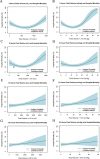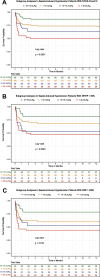Optimal fluid resuscitation targets in septic patients with acutely decompensated heart failure
- PMID: 39448976
- PMCID: PMC11520127
- DOI: 10.1186/s12916-024-03715-2
Optimal fluid resuscitation targets in septic patients with acutely decompensated heart failure
Abstract
Background: To determine the optimal fluid resuscitation volume in septic patients with acutely decompensated heart failure (ADHF).
Methods: Septic patients with ADHF were identified from a tertiary urban medical center. The generalized additive models were used to explore the association between fluid resuscitation volume and endpoints, and the initial 3 h fluid resuscitation volume was divided into four groups according to this model: < 10 mL/kg group, ≥ 10 to ≤ 15 mL/kg group, > 15 to ≤ 20 mL/kg group, and > 20 mL/kg group. Logistic and Cox regression models were employed to explore the association between resuscitation volume and primary endpoint, in-hospital mortality, as well as secondary endpoints including 30-day mortality, 1-year mortality, invasive ventilation, and ICU admission.
Results: A total of 598 septic patients with a well-documented history of HF were enrolled in the study; 405 patients (68.8%) had sepsis-induced hypoperfusion. Patients with NYHA functional class III and IV were 494 (83.9%) and 22 (3.74%), respectively. Resuscitation volumes above 20 mL/kg (OR 3.19, 95% CI 1.31-8.15) or below 10 mL/kg (OR 2.33, 95% CI 1.14-5.20) significantly increased the risk of in-hospital mortality in septic patients, while resuscitation volumes between 15 and 20 mL/kg were not associated with the risk of in-hospital death in septic patients (OR 1.79, 95% CI 0.68-4.81). In the multivariable Cox models, the effect of resuscitation volume on 30-day and 1-year mortality in septic patients was similar to the effect on in-hospital mortality. Resuscitation volume exceeds 15 mL/kg significantly increased the risk of tracheal intubation, while fluid resuscitation volume was not associated with ICU admission in the septic patients. In septic patients with hypoperfusion, these fluid resuscitation volumes have similar effects on patient outcomes. This association was consistent across the three subgroups with worsened cardiac function, as well as in sensitivity analyses.
Conclusions: Our study observed that an initial fluid resuscitation volume of 10-15 mL/kg in the first 3 h was optimal for early resuscitation in septic patients with ADHF, particularly those with worsened cardiac function. These results need to be confirmed in randomized controlled trials with larger sample sizes.
Keywords: Fluid resuscitation; Heart failure; ICU admission; Invasive ventilation; Mortality; Sepsis; Sepsis-induced hypoperfusion.
© 2024. The Author(s).
Conflict of interest statement
The authors declare no competing interests.
Figures



Similar articles
-
Assessment of Outcomes in Patients with Heart Failure and End-Stage Kidney Disease after Fluid Resuscitation for Sepsis and Septic Shock.J Emerg Med. 2024 Jun;66(6):e670-e679. doi: 10.1016/j.jemermed.2024.02.001. Epub 2024 Feb 16. J Emerg Med. 2024. PMID: 38777707
-
Fluid resuscitation and outcomes in heart failure patients with severe sepsis or septic shock: A retrospective case-control study.PLoS One. 2021 Aug 19;16(8):e0256368. doi: 10.1371/journal.pone.0256368. eCollection 2021. PLoS One. 2021. PMID: 34411178 Free PMC article.
-
Associations Between Volume of Early Intravenous Fluid and Hospital Outcomes in Septic Patients With and Without Heart Failure: A Retrospective Cohort Study.Crit Care Explor. 2024 Apr 26;6(5):e1082. doi: 10.1097/CCE.0000000000001082. eCollection 2024 May. Crit Care Explor. 2024. PMID: 38694845 Free PMC article.
-
Conservative versus liberal fluid resuscitation for septic patients at risk for fluid overload: A systematic review with meta-analysis.J Crit Care. 2025 Jun;87:155045. doi: 10.1016/j.jcrc.2025.155045. Epub 2025 Feb 28. J Crit Care. 2025. PMID: 40023080
-
Liberal versus conservative fluid therapy in adults and children with sepsis or septic shock.Cochrane Database Syst Rev. 2018 Dec 10;12(12):CD010593. doi: 10.1002/14651858.CD010593.pub2. Cochrane Database Syst Rev. 2018. PMID: 30536956 Free PMC article.
Cited by
-
Acute Kidney Injury During Sepsis and Prognostic Role of Coexistent Chronic Heart Failure.J Clin Med. 2025 Feb 3;14(3):964. doi: 10.3390/jcm14030964. J Clin Med. 2025. PMID: 39941634 Free PMC article. Review.
References
-
- Zhou X, Weng J, Xu Z, Yang J, Lin J, Hou R, et al. Effect of admission and discharge times on hospital mortality in patients with sepsis. Crit Care Med. 2023;51(3):e81–9. - PubMed
-
- Rhodes A, Evans LE, Alhazzani W, Levy MM, Antonelli M, Ferrer R, et al. Surviving sepsis campaign: international guidelines for management of sepsis and septic shock: 2016. Intensive Care Med. 2017;43(3):304–77. - PubMed
-
- Levy MM, Evans LE, Rhodes A. The surviving sepsis campaign bundle: 2018 update. Intensive Care Med. 2018;44(6):925–8. - PubMed
Publication types
MeSH terms
LinkOut - more resources
Full Text Sources
Medical
Research Materials
Miscellaneous

